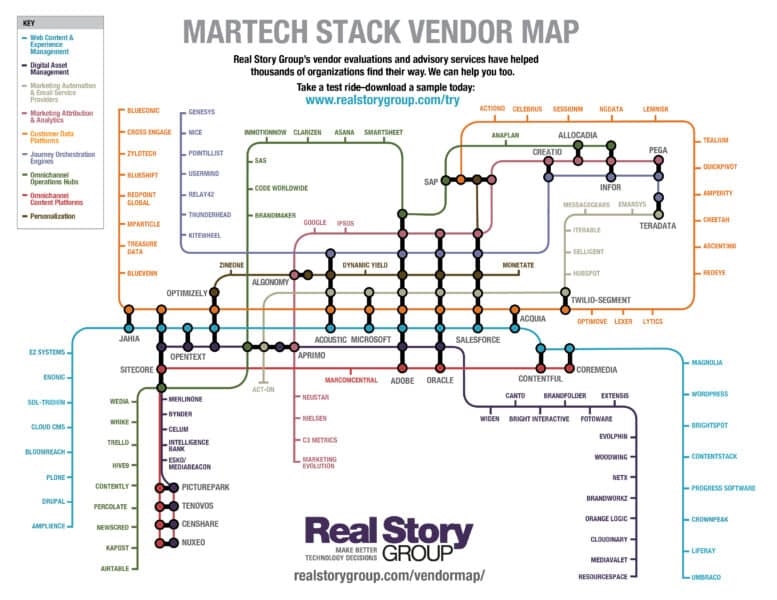Consider supply and demand chains for your marketing content
Conceptualizing a supply and demand chain for content makes it clear that a network of stakeholders is involved.
Business leaders frequently think in terms of supply chains and demand chains: processes and networks that drive inputs for your products and services, and then structure their eventual consumption. Could the same concepts apply for inputs and outputs from your martech stack?
On the content side, I think the answer is “yes.” There’s a growing sense that meaningful content drives the kinds of effective customer experiences that now lie at the heart of digital transformation. Consequently, some enterprises have started taking a closer look at just how that content gets produced and consumed — especially since the pandemic has accelerated everybody’s planning.
So you may find value in analyzing a “supply chain” and “demand chain” for marketing-oriented content and assets. At a recent Real Story Group MarTech Stack Leadership Council meeting, some member firms led a robust discussion of possibilities and pitfalls here. Here’s a high-level take on some of the themes and useful lessons.
Your Content Supply Chain
RSG subscribers report that demand for marketing and engagement content has expanded during the pandemic, with an attendant sense of just scraping by — “muscling through” among too many manual steps and poor coordination. How best to communicate this unsustainability to executives?
Crucially, many content challenges reside upstream from enterprise Digital Asset Management (DAM), Product Information Management (PIM), and Web Content Management (WCM) platforms. To the extent it’s labeled at all, some enterprises refer to this phase as “content marketing,” or “content operations,” but a couple RSG council members persuasively labeled the process as a “content supply chain.” That moniker helpfully connotes a network of internal players and external agencies contributing at different phases.
Supply chain as a concept also helps us understand content production and management as a process flow. Visually mapping the content supply chain was eye-opening to the execs at one R&D-heavy B2C firm, especially when aligned with product supply chain and marketing campaign planning, showing why content production needed to get engaged at each step, rather than as an afterthought at the end.
Business Case Booster
Describing a content supply chain creates the business justification for greater rationalization and centralization where necessary. For starters, you can gain efficiencies and therefore unit cost savings at a time when personalization programs are driving more content production. But a more compelling argument emerged around time-to-market: to keep executing ever-faster on marketing and engagement tactics, a firm needs to more pro-actively own its content processes and assets. (Interestingly, this parallels similar epiphanies around customer data: if you want to leverage it, you need to wrangle internal processes and create a central management hub somewhere.)
RSG Council members agreed that one of the first things any content supply chain business case should support is an enterprise taxonomy with rich tagging. It’s a precondition to effectively routing content through creation, production, distribution, and tracking. Note that savvy enterprises require external agencies to abide by their classification regimes as well.
An Omnichannel Future
Naturally the question arose about the technology underpinnings of any content supply chain. One council member deploys a “Collaboration DAM” for not-yet-approved asset management. This makes sense, and also anticipates today’s challenge that many “approved” assets are constantly getting revised for different channels.

More importantly, as we transition from thinking about supply chains to demand chains, then surely the future lies in managing omnichannel content components, featuring mixed text, media, and data that can be deployed to diverse contexts. Your existing DAM investments may not get you there. At RSG we see the slow emergence of a market for “Omnichannel Content Platforms,” the red line above.
Your Content Demand Chain
There are many dimensions to a content demand chain, but perhaps the most pressing is content performance. Which content drove higher KPIs?
It’s a really tough question to answer. Assets get deployed in a broader experience context, so was the asset itself determinative? Many marketing assets get compounded from multiple component assets, so which do you measure…parent or children? (Answer: both, though that’s hard.) How much does channel environment matter? And so on.
Yet some firms are working towards answers, and some nifty architectures are emerging. It starts with better usage tracking at the repository level, by setting up asset shopping and registration environments, or creating automated retrieval routines from front-end experience environments. As every asset manager knows, though, once assets or content fragments escape to the wild, you can easily lose track of them.

The larger story will be familiar to martech veterans. You need to up your game in enterprise analytics and data integration to create a better picture of content performance, then inject that data back into your content and asset management environments for better activation. Now if you’re thinking, “That sounds a lot easier said than done,” well, you’re right!
This approach continues a longer-term trend of extending localized metrics with true enterprise analysis, by employing advanced tools for data ingest, processing, integration, and stewardship. Like so many things in martech, your data science and data ops teams become your friend here. You also have to rethink your tagging strategy to accommodate omnichannel fragment tracking.
Finally, it means your management and engagement platforms need to be open to integrating external performance data at the asset level (many cannot) so marketers can make informed decisions “at the source.” At RSG lately we’ve been putting more emphasis on these types of integrated user stories when advising MarTech selection teams.
Read next: Real Story on MarTech: The new stack
Content and Data in Context
This council session was a nice follow-on to the previous meeting on personalization, where content components, assembly, and tracking arose as hot topics. Personalization requires content variants. How will you supply them? You’ll likely need to rethink the content supply chain.
And of course personalization requires solid customer data management. Most of you have not progressed as far as you’d like in the data realm. Yet I get the sense that as we all get savvier about building and activating customer segments, the pendulum is swinging back a bit towards effective content and asset management. You can now micro-tune your engagement to smaller audiences. What will you say? And how will you track the efficacy of that message? Customer data management and content management are a double-helix.
The post Real Story on MarTech: Consider supply and demand chains for your marketing content appeared first on MarTech.
(57)



